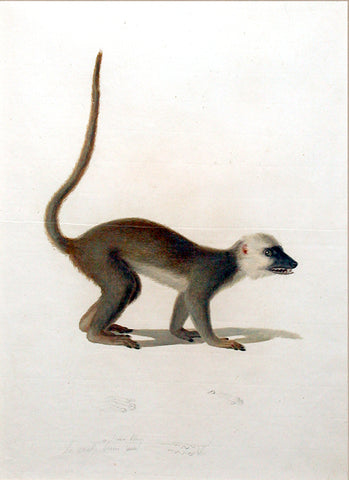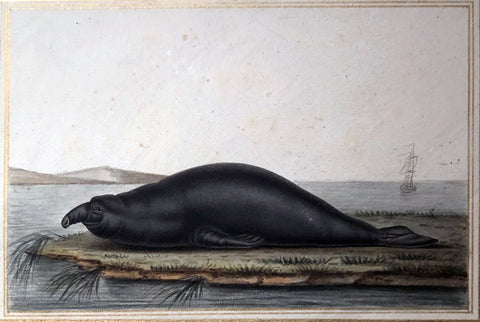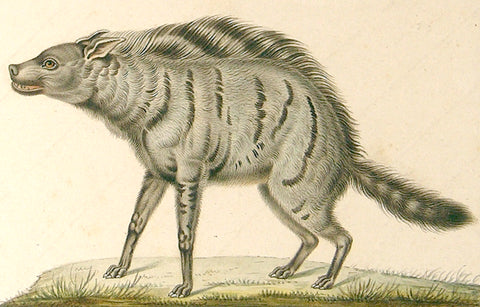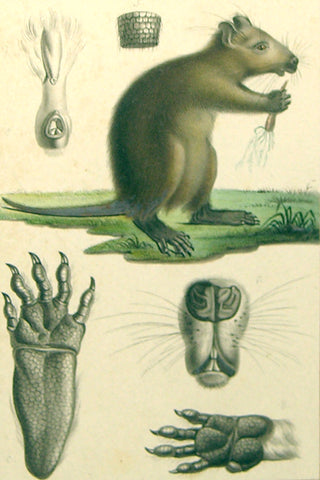
Jean-Baptiste Audebert (French, 1759-1800) “Le maki brun”
Jean-Baptiste Audebert (French, 1759-1800)
“Le Maki a font blanc Lemus Albifrons”
Original watercolor study for prepared for figure III page 12
Histoire Naturelle de Singes et des Makis [The Natural History of Apes and Monkeys]
Watercolor and gouache on paper
Ca. 1790-1800
Annotated in pencil
Paper size: 16 ½ x 12 in
Frame size: 27 ¾ x 23 ¼ in
The white-headed lemur (Eulemur albifrons), also known as the white-headed brown lemur, white-fronted brown lemur, or white-fronted lemur, is a species of primate in the family Lemuridae. It is only found in north-eastern Madagascar. It is arboreal and is usually found in rainforest treetops.
In the twilight years of the Ancien Régime and following its upheaval, a group of revolutionary French thinkers emerged, nurtured at the Jardin des Plantes, which later became the Musée National d’Histoire Naturelle. One of the earliest was Georges-Louis Leclerc, Comte de Buffon, who suggested that species could undergo organic changes. In his monumental work, Histoire Naturelle, begun in 1749, he highlighted the similarities between humans and apes, even proposing a common ancestry. His ideas influenced other prominent figures, including Étienne Geoffroy St. Hilaire, Georges Cuvier, and Jean-Baptiste Lamarck.
Amidst this exhilarating climate of scientific discovery, a new generation of artists found themselves in an unexpected role, engaging in the intricate world of zoological and ornithological illustration. Among the greatest talents in this field were Nicholas Robert, Pierre Joseph Redouté, and Gerard van Spaendonck. Yet, Jean-Baptiste Audebert distinguished himself with his exceptional talent for painting primates. His highly esteemed work, Histoire Naturelle de Singes et des Makis (Natural History of Apes and Monkeys), is heralded as one of the pioneering masterpieces of the golden age of French natural history publications.
Audebert hailed from Rochefort, where he received training as a miniaturist painter. This early education endowed him with a remarkable capacity to capture intricate details—an invaluable skill for a scientific illustrator—and it is a talent that shines through in his exquisite watercolor studies. His journey into the world of natural history began with a significant commission to create plates for Guillaume Antoine Olivier’s Entomologie, published between 1789 and 1808. He also contributed to Oiseaux dorés ou à reflets métalliques (Golden Birds or of Metallic Sheen), a work that was underway in the year of his death, 1800. It was within this context that Audebert produced the present watercolors, which served as studies for the only work he would see completed during his lifetime, released in ten parts between 1797 and 1800.
Audebert’s innate artistic skill allowed him to balance the scientific rigor of his illustrations with an understanding of their aesthetic allure. Each study he created not only depicted the monkey’s form and anatomy but also captured their distinctive characteristics and mannerisms. In doing so, he reflected many of the evolving theories posited by his esteemed contemporaries in France, laying foundational stones for the later monumental writings of Charles Darwin. Therefore, Audebert’s studies stand as a dual testament: they are not only visually stunning but also significant in their contribution to the advancement of modern science. His work embodies a perfect union of science and art, celebrating the beauty of the natural world while uncovering its secrets.
We Also Recommend


![Anonymous, Le Lapin Domestique [Domestic Rabbit]](http://aradergalleries.com/cdn/shop/products/DSCN7726_large.jpg?v=1584634225)


